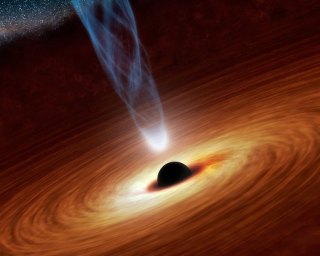NASA telescope captures rare black-hole event

The corona is pictured here as the white light. Image: NASA/Caltech
The black hole in question, referred to as Markarian 335, is about 324 million light-years from Earth in the direction of the Pegasus constellation.
The corona, a compact source of X-rays that sits near the black hole, has moved closer to the black hole over a period of just days. The movement was captured by NASA's Nuclear Spectroscopic Telescope Array. A paper on the findings appears in the Monthly Notices of the Royal Astronomical Society.
As the corona shifted closer to the black hole, the gravity of the black hole exerted a stronger tug on the X-rays emitted by it. The result was an extreme blurring and stretching of the X-ray light. Such events had been observed previously, but never to this degree and in such detail.
Supermassive black holes are thought to reside in the centers of all galaxies. Some are larger and rotate faster than others. Markarian 335 squeezes about 10 million times the mass of our sun into a region only 30 times the diameter of the sun, and it spins so rapidly that space and time are dragged around with it.
Even though some light falls into a supermassive black hole never to be seen again, other high-energy light emanates from both the corona and the surrounding accretion disk of superheated material. Astronomers are uncertain of the shape and temperature of coronas, but they know that they contain particles that move close to the speed of light.
NASA's Swift satellite has monitored this black hole for years and recently noted a dramatic change in its X-ray brightness.
Follow-up observations indicate the corona still is in this close configuration, months after it moved. Researchers don't know whether and when the corona will shift back.The NuSTAR observations reveal that the grip of the black hole's gravity pulled the corona's light onto the inner portion of its superheated disk, better illuminating it. Almost as if somebody had shone a flashlight for the astronomers, the shifting corona lit up the precise region they wanted to study.
The new data could help determine more about the mysterious nature of black hole coronas. In addition, the observations have provided better measurements of the black hole's furious relativistic spin rate. Relativistic speeds are those approaching the speed of light, as described by Albert Einstein's theory of relativity.
Related:
NASA telescope unravels supernova mystery
NASA: High-energy X-Ray view of 'Hand of God'

